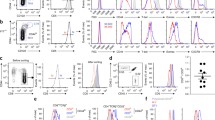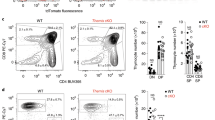Abstract
Identity at the major histocompatibility complex (MHC) of primed T cells and macrophages was essential for the development of a T cell proliferative response to Purified Protein Derivative of tuberculin (PPD) in the presence of macrophage-associated antigen and potential allogeneic effects were eliminated by the use of one-way fetal liver chimeras as a T cell source. By contrast, such MHC restriction could not be shown for the T cell—macrophage interaction when antigen was present in soluble form.
It was found that the proliferative response of primed (responder × nonresponder) F1 T cells to the Ir-gene controlled antigen, TNP-18 [Glu-Tyr-Lys (TNP) (Glu-Tyr-Ala)5], could only be restored by responder macrophages with bound antigen, while both responder and nonresponder macrophages reconstituted the response to soluble TNP-18. Supernatants from cultured responder or nonresponder macrophages could at least partially replace viable macrophages in the latter case.
These results argue for two distinct antigen presentation mechanisms, depending on the physical state of the antigen rather than its chemical nature: one involves recognition of antigen in association with MHC-coded determinants and shows H-2 restriction, while the other, mediated by soluble factors and antigen, does not.
Similar content being viewed by others
References
Barton, M. A., Singh, B., and Fraga, E.: Synthetic polypeptide antigens of defined geometry.J. Am. Chem. Soc. 99:8491–8498, 1977
Calderon, J., Kiely, J.-M., Lefko, J. L., and Unanue, E. R.: The modulation of lymphocyte functions by molecules secreted by macrophages. I. Description and partial biochemical analysis.J. Exp. Med. 142:151–164, 1975
Erb, P. and Feldmann, M.: Role of macrophages in in vitro induction of T helper cells.Nature 254: 352–354, 1975 a.
Erb, P. and Feldmann, M.: The role of macrophages in the generation of T helper cells. III. Influence of macrophage-derived factors in helper cell induction.Eur. J. Immunol. 5:759–765, 1975 b
Erb, P., Meier, B., Matsunaga, T., and Feldmann, M.: Nature of T-cell macrophage interaction in helper-cell induction in vitro. II. Two stages of T helper cell differentiation analyzed in irradiation and allophenic chimeras.J. Exp. Med. 149:686–701, 1979
Gorcynski, R. M.: Control of the immune response: role of macrophages in regulation of antibody- and cell-mediated immune responses.Scand. J. Immunol. 5:1031–1047, 1976
Julius, M. H., Simpson, E., and Herzenberg, L. A.: A rapid method for the isolation of functional thymus-derived murine lymphocytes.Eur. J. Immunol. 3:645–649, 1973
Katz, K. H., Hamaoka, T., Dorf, M. E., Maurer, P. H., and Benacerraf, B.: Cell interactions between histoincompatible T and B lymphocytes. The H-2 gene complex determines successful physiologic lymphocyte interactions.Proc. Natl. Acad. Sci. U.S.A. 70:2624–2628, 1973
Katz, D. H.: The role of the major histocompatibility complex in lymphocyte differentiation.Cold Spring Harbor Symp. Quant. Biol. 47:611–624, 1977
Lee, K. C., Singh, B., Barton, M. A., Procyshyn, A., and Wong, M.: A simple reliable system for studying murine T cell proliferation.J. Immunol. Methods 25:159–170, 1979
Marrack, P. and Kappler, J. W.: The role of H-2 linked genes in helper T cell function. VI. Expression ofIr genes by helper T cells.J. Exp. Med. 149:780–785, 1979
Miller, J. F. A. P. and Vadas, M. A.: The major histocompatibility complex: influence on immune reactivity and T lymphocyte activation.Scand. J. Immunol. 6:771–778, 1977
Pierce, C. W., Kapp, J. A., and Benacerraf, B.: Regulation by the H-2 gene complex of macrophagelymphoid cell interactions in secondary antibody responses in vitro.J. Exp. Med. 144:371–381, 1976
Pierres, M. and Germain, R. N.: Antigen-specific T cell-mediated suppression. IV. Role of macrophages in generation of L-Glutamic Acid60-L-Alanine30-L-Tyrosine10 (GAT)-specific suppressor T cells in responder mouse strains.J. Immunol. 121:1306–1314, 1978
Rosenthal, A. S. and Shevach, E. M.: Function of macrophages in antigen recognition by guinea pig T lymphocytes. I. Requirement for histocompatible macrophages and lymphocytes.J. Exp. Med. 138:1194–1212, 1973
Rosenthal, A. S.: Determinant selection and macrophage function in genetic control of the immune response.Immunol. Rev. 40:135–152, 1978
Rosenwasser, L. J. and Rosenthal, A. S.: Adherent cell function in murine T lymphocyte antigen recognition. II. Definition of genetically restricted and nonrestricted macrophage functions in T cell proliferation.J. Immunol. 121:2497–2501, 1978
Shevach, E. M. and Rosenthal, A. S.: Function of macrophages in antigen recognition by guinea pig T lymphocytes. II. Role of the macrophage in the regulation of genetic control of the immune response.J. Exp. Med. 138:1213–1229, 1973
Singh, B., Fraga, E., and Barton, M. A.: Characterization and genetic control of the immune response to synthetic polypeptide antigens of defined geometry.J. Immunol. 121:784–789, 1978
Sprent, J. and von Boehmer, H.: T-helper function of Parent→F1 chimeras. Presence of a separate T-cell subgroup able to stimulate allogeneic B cells but not syngeneic B cells.J. Exp. Med. 149:387–397, 1979
Vadas, M. A., Miller, J. F. A. P., Whitelaw, A. M., and Gamble, J. R.: Regulation by the H-2 gene complex of delayed-type hypersensitivity.Immunogenetics 4:137–153, 1977
von Boehmer, H., Hudson, L., and Sprent, J.: Collaboration of histoincompatible T and B lymphocytes using cells from tetraparental bone marrow chimeras.J. Exp. Med. 142:989–997, 1975
Waldmann, H., Pope, H., Brent, L., Bighouse, K.: Influence of the major histocompatibility complex on lymphocyte interactions in antibody formation.Nature 274:166–168, 1978
Waldmann, H., Pope, H., Bettles, C., and Davies, A. J. S.: The influence of the thymus on the development of MHC restrictions exhibited by T helper cells.Nature 277:137–138, 1979
Yano, A., Schwartz, R. H., and Paul, W. E.: Antigen presentation in the murine T lymphocyte proliferative response. II. Ir-GAT-controlled T lymphocyte responses require antigen-presenting cells from a high responder donor.Eur. J. Immunol. 8:344–347, 1978
Zinkernagel, R. M., Callahan, G. N., Althage, A. Cooper, S., Streilein, J. W., and Klein, J.: The lymphoreticular system in triggering virus plus self-specific cytotoxic T cells: evidence for T help.J. Exp. Med. 147:897–911, 1978
Author information
Authors and Affiliations
Rights and permissions
About this article
Cite this article
Brown, E.R., Singh, B., Lee, K.C. et al. MHC control of T lymphocyte-macrophage interactions. Immunogenetics 9, 33–43 (1979). https://doi.org/10.1007/BF01570391
Received:
Revised:
Issue Date:
DOI: https://doi.org/10.1007/BF01570391




